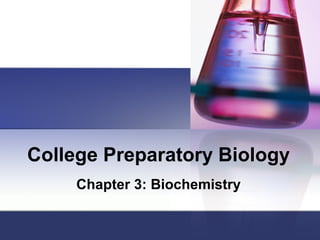
k
- 1. College Preparatory Biology Chapter 3: Biochemistry
- 2. Write into the day Why do Carbon molecules form the chemical backbone for all living things? Answer: because of its chemical structure.
- 3. Organic vs. Inorganic Organic molecules- made primarily of carbon atoms. Inorganic compounds- usually do not contain carbon. For the following list of items, determine if each is organic or inorganic: Wool, cotton, glass rod, paper, potted plant, carbon dioxide.
- 4. Section 1:Carbon Compounds Most matter in living organisms that is not water is organic matter. Carbon has 4 valence electrons, therefore, it can form 4 covalent bonds with atoms. Carbon has the ability to exist in straight chains, branched chains, or rings.
- 6. Carbon Bonding Carbon can form single, double, or triple bonds.
- 9. Functional Groups Cont… Functional groups influence the properties of a compound. They can make a compound hydrophobic, hydrophilic, polar or non-polar. They can also make boiling point or rate of evaporation higher or lower.
- 10. Large Carbon Compounds Monomers= single unit Dimers= two units Trimers= three units Polymers= many units Large polymers are called macromolecules.
- 11. Dehydration Synthesis Reaction Take away water to add molecules together
- 12. Hydrolysis Reaction Add water to break apart molecule
- 13. Energy Currency ATP (Adenosine Triphosphate) stores a large amount of energy in one of the phosphate bonds This energy is used for chemical reactions in the body.
- 14. Section 2: Molecules of Life 4 main classes of organic compounds are essential to life: Carbohydrates Lipids Proteins Nucleic Acids
- 15. Carbohydrates Composed of C, H, and O atoms. C, H, O are in a ratio of 1:2:1. The monomer of carbohydrates is a monosaccharide. Some examples of monosaccharides are Glucose, Fructose, and Galactose.
- 16. Monosaccharides
- 17. Monosaccharides, Disaccharides and Polysaccharides The prefixes ‘Mono’, ‘Di’, and ‘Poly’ mean ‘one’, ‘two’, and ‘many’, respectively. ‘Saccharide’ means ‘sugar’. A monosaccharide is the monomer for carbohydrates. 2 monosaccharides make up a disaccharide Many monosaccharides make up a polysaccharide.
- 18. Examples of Carbohydrates Monosaccharide- Glucose, fructose, and galactose. Disaccharides- Sucrose, Maltose, and Lactose Polysaccharides- Glycogen (Storage form of energy in animals); Starch (storage form of energy in plants).
- 19. Polysaccharides
- 20. Lipids Composed of the elements C, H, and Oxygen. The monomers of lipids are glycerol and fatty acid. Some examples of lipids are phospholipids, testosterone, estrogen, ear wax. Saturated fatty acid- carbon has as many hydrogen atoms bonded to it as possible and there are no double bonds Unsaturated- carbon does not have as many hydrogens bonded to it as possible and has double binds to compensate.
- 21. Lipid Structure
- 23. Steroids
- 24. Proteins Contain the elements C, H, N, and O. The monomers of proteins are amino acids. There are 20 different amino acids Amino acids have 4 parts: Amino group, central carbon, R group, and Carboxyl group.
- 26. Enzymes Are proteins that catalyze biological reactions. Enzymes have a binding site (Active site) that allows a molecule (substrate) to bind to it and change. Enzymes can only work at a specific pH, Temperature, and Salinity level.
- 28. Nucleic Acids Contains elements C, H, O, N, and P. Store and transfer specific information about an organism. Make up DNA (Deoxyribonucleic acid) Consist of a phosphate group, a sugar, and a nitrogenous base.
- 29. Nucleic Acid
- 30. DNA